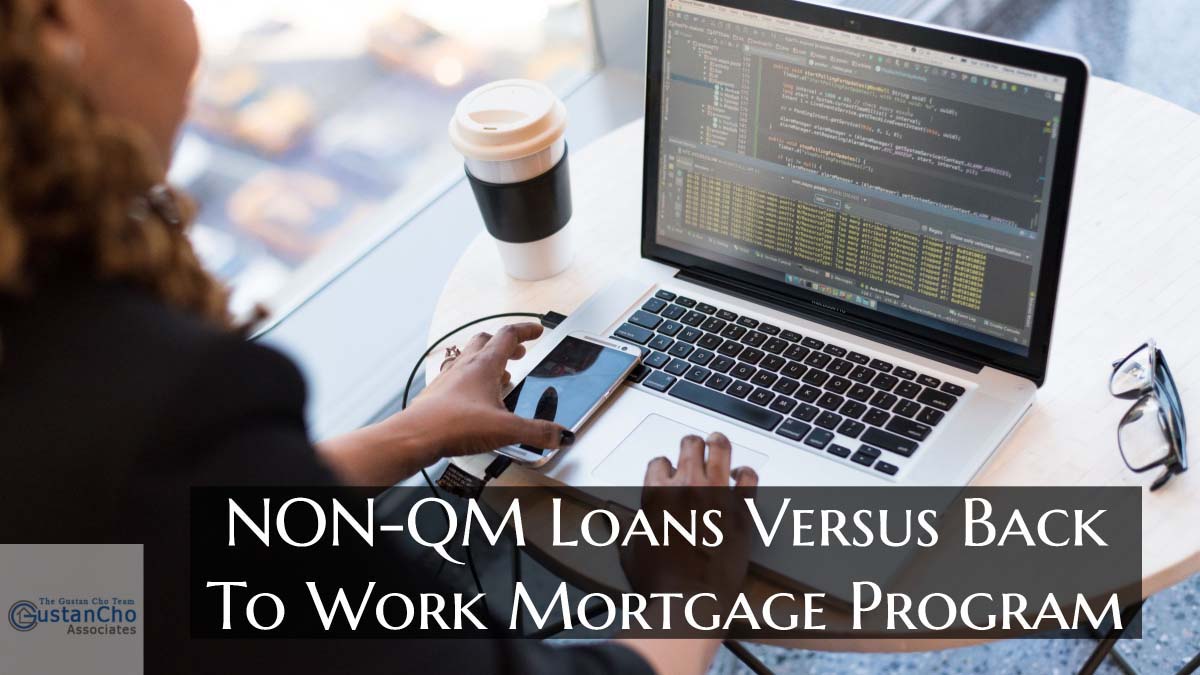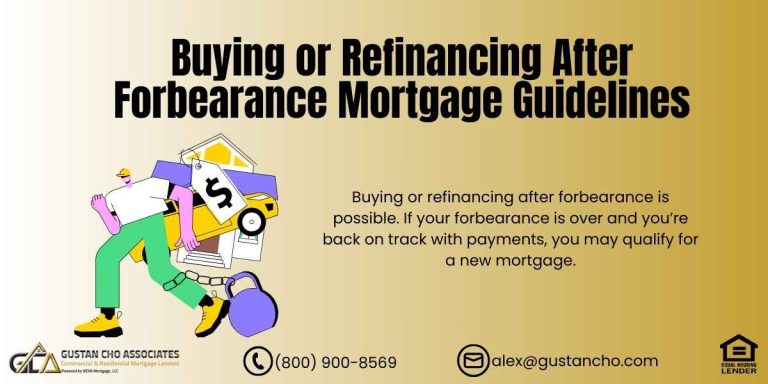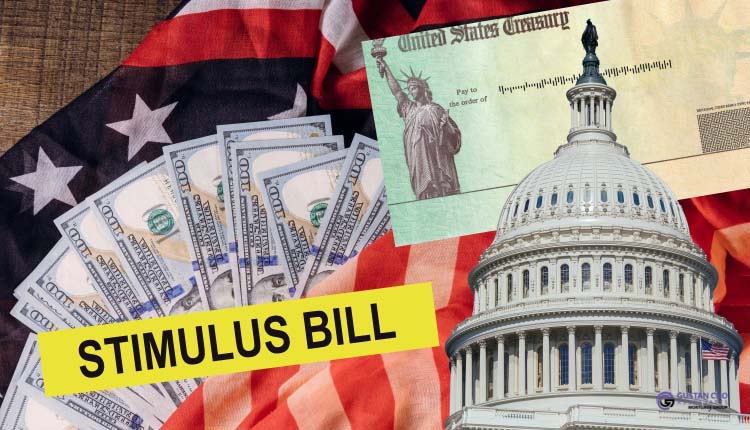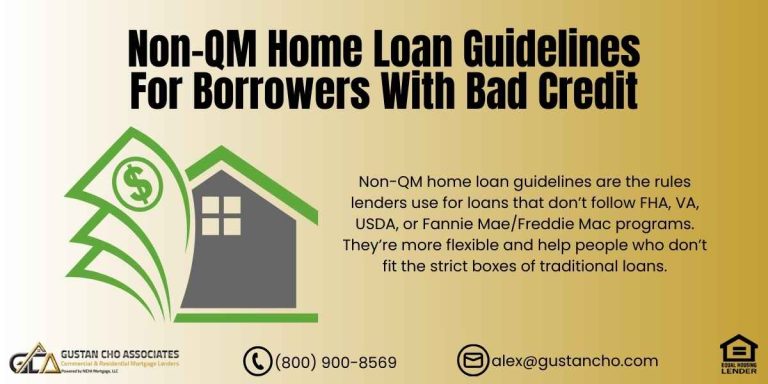This guide covers non-QM vs back-to-work loans. Many non-QM lenders are willing to extend credit much sooner than it takes for a borrower to recover from bankruptcy, foreclosure, or short sale. Traditional programs do not offer the same ease of access. However, FHA requires 2-3 years of seasoning, and Fannie Mae takes between 4-7 years. All government and conventional loan programs have waiting period requirements after the following:
- Chapter 7 Bankruptcy
- Foreclosure
- Deed instead of Foreclosure
- Short Sale
Everyone thought this program would open up doors to many homebuyers who have recovered from bankruptcy and/or foreclosure and enable them to purchase a home after a one-year waiting period. Everyone who qual, but most mortgage lenders were scared to touch it. In the following paragraphs, we will cover NON-QM vs. ified applied to get turned down. Certain requirements apply to the back-to-work mortgage loan program.. But most mortgage lenders were scared to touch it. In the following paragraphs, we will cover NON-QM vs back-to-work loans.
Non-QM vs Back to Work Loans: Key Differences for Homebuyers
Homeownership is a dream for many. However, the path to it is not straightforward. Several obstacles can get in the way. Many Americans have to suffer through all of it, whether it be a loss of income, bankruptcy, or financial hardships.
The Back to Work Program, FHA has given a second chance to borrowers who have suffered through so many economic events and are attempting to get back into the housing market.
This program ended in 2016, leaving borrowers needing other solutions. Non-QM loans, or Non-Qualified Mortgage Loans, answer this problem. They offer flexible options to borrowers who do not fit a traditional lender’s mold. This article highlights the differences between non-QM and Back-to-Work Loans, what each program aims to achieve, and ultimately argues that non-QM loans are the most favorable option come 2025.
Compare NON-QM and Back to Work Loan Options
Whether you’re self-employed, recently had a credit event, or don’t fit traditional guidelines, we’ll help you decide if a NON-QM or Back to Work program is right for you.
What Are Non-QM Loans?
Non-QM loans are a type of mortgage not covered by the Consumer Financial Protection Bureau’s definition of qualified mortgages. Non-QM lenders do not require the rigid debt-to-income ratio rules and income documentation that other lenders do. Instead, they review a borrower’s complete financial situation. This type of loan helps people who cannot get a traditional mortgage.
Non-QM loans are very popular among the self-employed sector, real estate investors, and high net worth individuals who would rather pledge assets, use alternative documentation, or do not want to provide tax returns.
Recent bankruptcies, foreclosures, and other credit challenges have made it difficult for non-QM loan borrowers to obtain them due to the absence of long waiting periods enforced by FHA, VA, and conventional loans. Non-QM loans are advantageous for borrowers who want to skip the traditional methods of income documentation, such as tax returns, payslips, and wages, to be verified or reviewed. They can finance most jumbo loans that surpass the FHA or other conforming loan limits.
What was the Back to Work mortgage program?
One of the initiatives taken by the Federal Housing Administration (FHA) was the Back to Work mortgage program, which was unveiled in 2013 as a response to the Great Recession. The Great Recession devastated many by causing them to lose jobs, homes, and savings. FHA’s priority was to create a pathway to homeownership.
Under the Back to Work program, a borrower could qualify for a new FHA loan a year after completing a foreclosure, short sale, or bankruptcy.
This was a massive change since FHA’s policy required foreclosure of a loan and short sale to not qualify for a loan for 2 to 7 or even more years. The change allowed many families to recover and rebuild their lives. To qualify for the program, a borrower had to show proof that the financial struggle was linked to a more significant economic hardship, like a job loss.
The Absence of Back-to-Work Programs
Qualified loans and Back to Work loans are like night and day. The former is always accessible in today’s market, while the latter has been shelved. Non-QM loans Back to Work loans are federally insured FHA products, while Back to Work loans are non-QM loans that banks, mortgage firms, and private investors lend.
The borrower had to meet FHA guidelines and undergo a step-by-step process, such as HUD-sanctioned housing counseling and full financial recovery.
The Back to Work Program was under the HUD guidelines for developing and maintaining housing and the urban environment, so it had very stringent paperwork rules. Non-QM loans specialize in flexible underwriting, so they offer bank statement loans for the self-employed or real estate investors. High-net-worth clients will still pass the scrutiny of stringent NMFC qualifying.
Waiting Period After Bankruptcy and Foreclosure
Waiting periods are another area that illustrates the difference between the programs. Back to Work has drastically reduced FHA’s standard waiting periods to one year after a foreclosure, bankruptcy, or short sale. Non-QM loans take this a step further by eliminating mandatory waiting periods in several situations.
If a borrower has adequate income, reserves, or assets to demonstrate repayment capability, they could be approved for a non-QM loan almost immediately after a credit incident.
The county loan limits also separate the two. Under the Back to Work program, the county limits capped FHA loan amounts. Non-QM loans have no restrictions, enabling borrowers to finance more expensive homes and even certain jumbo properties. Then there are the down payments. FHA loans have more affordable down payments, as low as 3.5 percent. Non-QM loans have higher down payments, at 10 to 20 percent, depending on the borrower’s profile, credit score, and the type of documentation used.
Why Non-QM Loans Matter in 2025
In the market today, the void left by the Back to Work program is being filled by non-QM loans. Non-QM loans tend to be the go-to option for borrowers who are finding it hard to get approved for FHA, VA, or Conventional loans. This is especially crucial for self-employed people, who are an ever-increasing part of the US workforce.
Write-offs frequently diminish deductible income to amounts that make it impossible for the person to acquire a conventional mortgage.
Non-QM programs resolve this issue by assessing the gross deposits on the bank statements rather than determining income. Real estate investors are also beneficiaries of Non-QM loans. DSCR loans permit them to qualify based on the rental income of the property rather than their own earnings. This enables investors to expand their portfolios without being constrained by conventional underwriting guidelines.
Which Loan Is Right for You?
In 2025, choosing between non-QM loans and the Back to Work program is simple because the former no longer exists. It is unavailable to borrowers, and no equivalent FHA program has replaced it.
For a borrower today, the practical option is non-QM loans. They are creative and flexible, offering the borrowers the chance for home ownership they wouldn’t have gotten otherwise.
Non-QM loans are surely more expensive than FHA loans in terms of interest and down payment. However, unlike non-QM loans, FHA loans have a much narrower eligibility and are unavailable in real time. FHA chose not to extend it because churn had stabilized in the housing market, micro-level unemployment had dropped, and foreclosures had normalized. The FHA hasn’t issued official replacements, which suggests gaps for borrowers with changed financial situations.
Key Takeaways
For borrowers, the FHA Back To Work program was a major but short-lived assistance option after the Great Recession. It ended in 2016 and has not returned since. Dale Elenteny, a senior mortgage loan originator at Gustan Cho Associates says the following about Non-QM vs Back to Work Loans:
Non-QM loans, however, are still alive and well in 2025 and assist real estate investors, self-employed individuals, and anyone facing financial difficulties.
The choice is obvious if you are trying to decide between non-QM loans and Back-to-Work Loans. Non-QM loans are a much more modern and versatile option compared to back-to-work loans, which aren’t available anymore. Thus, non-QM loans can help you meet your aspirations for homeownership.
Find the Right Mortgage Fit for Your Situation
Back to Work loans help buyers after hardship, while NON-QM loans offer flexibility for unique income or credit scenarios. Our experts will guide you to the best choice.
FAQs: Non-QM vs Back to Work Loans
Is the FHA Back to Work Program Still Available in 2025?
- No, it expired in 2016.
- Borrowers are now required to look for Non-QM loans.
What Differentiates Non-QM Loans From FHA Loans?
- Unlike the FHA loans, non-QM loans have flexible documentation and higher loan limits and are assessed individually.
How Long After Bankruptcy Can You Get A Mortgage?
- Yes.
- Some Non-QM lenders approve borrowers sooner than the FHA’s old one-year Back to Work timeline.
- Not always.
- Many programs allow scores in the 600 range if other strengths exist.
- It was a temporary recession-recovery program.
- Once the market stabilized, FHA allowed it to expire.
- They typically have higher interest rates but provide access to otherwise unavailable financing.
- Yes.
- Many use bank statements instead of tax returns to qualify.
- Usually 10 to 20 percent, depending on credit and documentation type.
- Some investment-focused Non-QM loans do, but not all.
- Borrowers should review loan terms carefully.
- If you do not qualify for FHA, VA, or Conventional loans, Non-QM is often the best path to homeownership.
- At Gustan Cho Associates, we strive to help borrowers who do not meet typical mortgage criteria.
- We have options if you are self-employed, going through bankruptcy, or have been turned down by a different lender.
- We are happy to offer non-QM mortgage options for those who have been denied financing from other lenders.
Call us now at 800-900-8569 or Apply Now to start the process.
Home Loan After Bankruptcy and Housing Event
However, many hard-working Americans who have filed bankruptcy and/or had a housing event recover much sooner than the standard mandatory waiting period after bankruptcy and foreclosure.
HUD, the parent of FHA, launched a pilot FHA Loan Program called BACK TO WORK MORTGAGE, where it reduced the traditional waiting period to one year
This program became a flop, and HUD eventually canceled the FHA Back To Work Mortgage Program. This blog post is a rewrite of an article we wrote about when it was launched in 2013.
FHA Back To Work Was Launched In 2013
Christmas came early this year for homebuyers who had a previous bankruptcy, foreclosure, short sale, or deed-in-lieu-of-foreclosure in August 2013. Marga Jurilla, the executive assistant at Gustan Cho Associates, says the following about Non-QM vs Back to Work Loans:
If the borrower rents their unit from a property management company, a letter from the property management company will be sufficient.
Again, most lenders did not want to touch it, even if borrowers qualified for this mortgage loan program. Countless home buyers were waiting for this FHA Back To Work mortgage program, which shortened the period after bankruptcy and housing events to one year.
NON-QM vs Back to Work Loans: The Back To Work Program Was a Complete Disaster
Unfortunately, the Back-to-Work Mortgage was a major five-star disaster. Millions of Americans lost their jobs and homes due to the Great Recession of 2008. Many were forced into bankruptcy, and many lost their homes through foreclosure. The entire mortgage industry underwent a major overhaul.
Many mortgage loan products, such as no-doc loans, stated income loans, and teaser rate loans, have completely disappeared from the industry.
Thousands of subprime mortgage lenders literally closed their homes, and millions of loan originators were forced out of business due to strict new licensing guidelines and the loss of subprime business. Those mortgage loan originators who weathered the storm had to adapt to a new system. They had to learn the new mortgage guidelines. Loan officers needed to obtain new licensing, such as taking national and state examinations and undergoing criminal and financial background checks.
Current Waiting Period After Bankruptcy and Foreclosure To Qualify For a Home Loan
The current waiting period for home buyers differs depending on the mortgage loan program. The waiting period for VA and FHA loans is 2 years from the discharge date of a Chapter 7 Bankruptcy. Fannie Mae and Freddie Mac require a four-year waiting period after the Chapter 7 Bankruptcy discharge date to qualify for conventional loans.
To qualify for FHA Loans, the current waiting period requirements for homebuyers who had a prior foreclosure, short sale, or deed in lieu are three years from the date the foreclosure or deed in lieu was recorded on the county records.
With VA Loans, it is two years. Three years is a long time. FHA announced the Back to Work mortgage loan program in August 2013. This program shortened the waiting period to one year from the Chapter 7 bankruptcy discharge date and one year from the recorded date after a foreclosure, deed instead of foreclosure, or short sale.
Minimum Qualification For NON-QM vs Back to Work Loans
There were strict qualification requirements for back-to-work FHA loans. Not everyone will qualify for the new FHA back-to-work loans. The first and foremost important criterion is that FHA requires a good explanation of the extenuating circumstances for why the borrower had to file bankruptcy and/or have a foreclosure, deed in lieu, or short sale.
They are looking for evidence that the borrower was unemployed or had an income reduction of at least 20%, which caused the borrower to file bankruptcy or foreclosure.
After filing bankruptcy and/or having a foreclosure, FHA wants to see that the mortgage loan borrower has re-established their credit and has not had a late payment in the prior 12 months. The mortgage loan borrower needs rental verification, and the only way rental verification can be proven is by providing canceled checks, which are payable to the landlord for the previous 12 months.
NON-QM vs Back to Work Loans Underwriting Requirement
NON-QM vs back-to-work loans: All back-to-work loans needed to be manually underwritten. Only lenders that do manual underwriting can do back-to-work loans. Your best bet is to contact a mortgage broker with access to wholesale lenders who do manual underwrites. However, only a fraction of these mortgage applications received conditional loan approvals, and even fewer were closed.
Don’t Let Past Credit Issues Hold You Back
Even with bankruptcy, foreclosure, or self-employment hurdles, we’ll match you with the right program for approval.
Qualify For Home Loan With NON-QM Loans With No Waiting Period After Housing Event
The NON-QM vs. back-to-work loans are a great option for homebuyers who cannot meet the waiting period on FHA loans. Housing prices are double-digit in many parts of the country, and the Program is a great short-term financing option. Gustan Cho Associates has an alternative financing program for homebuyers who do not meet the waiting period requirement after a previous housing event:
- Foreclosure
- Short Sale
- Deed instead of Foreclosure
NON-QM vs Back to Work Loans
NON-QM Loans do not require any waiting period after a housing event. However, 10% to 20% down payment is required. Mortgage Interest Rates are higher than standard FHA loans. Christy Hembree, a senior mortgage loan originator at Gustan Cho Associates says the following about non-QM vs Back to Work Loans:
Most homebuyers can close their home loans with NON-QM Loans, and when they meet the waiting period requirements, can refinance into a government and/or conventional loan.
Homebuyers who do not meet the waiting period requirements on government and/or conventional loans can qualify for NON-QM loans. Contact Gustan Cho Associates at 800-900-8569 or text us for a faster response. Or email us at gcho@gustancho.com. We are available 7 days a week, evenings, weekends, and holidays.
FHA Back To Work Extenuating Circumstances Mortgage Loan Program: DISCONTINUED
HUD just launched the Back to Work Extenuating Circumstances due to economic event mortgage loan program, which shortens the waiting period for those who have filed bankruptcy, had a foreclosure, a deed instead of foreclosure, or a short sale to one year. Mike Gracz, a senior mortgage loan originator at Gustan Cho Associates says the following about Non-QM vs Back to Work Loans:
There are strict rules and regulations, and not everyone can qualify. Due to an economic event, mortgage loans are manually underwritten in the Back to Work Extenuating Circumstances.
So not every lender can process and underwrite these mortgage loans. Banks cannot do them, and only a few select mortgage bankers participate in this program.
FHA Back To Work: Extenuating Circumstances Qualifications
Back to Work: Extenuating Circumstances due to an “Economic Event”
An “Economic Event” is when a borrower has experienced an occurrence beyond their control, resulting in a loss of income, employment, or a combination of both. The manual downgrade of an “Accept/Approve” recommendation may be eligible for FHA purchase transaction financing, provided all the following requirements are met:
- The Economic Event lasted at least six months.
- The “Economic Event” resulted in a 20% or more reduction in the borrower’s household income.
- Documented evidence that the delinquencies were due to the “Economic Event” must be provided.
- The borrower must have re-established a Satisfactory Credit history for at least 12 months without any late payments in the past 12 months.
- The borrower must have fully recovered from the “Economic Event”.
Other Requirements For the FHA Back to Work Mortgage Loan Program
Borrowers who are qualified candidates for the new FHA Back to Work Extenuating Circumstances mortgage loan program must ensure they get their signed housing counseling certificate as soon as possible. The mortgage application cannot be started until 30 days after you receive your HUD-approved housing counseling certificate.
UPDATE on NON-QM vs Back to Work Loans
As mentioned earlier, the Back To Work Extenuating Circumstances mortgage loan program no longer exists due to an economic event. NON-QM Loans offered by Gustan Cho Associates have no waiting period after a housing event and one year after bankruptcy. John Strange, a senior mortgage loan originator at Gustan Cho Associates says the following about Non-QM vs Back to Work Loans:
Non-QM loans does require a 20% down payment. Bank Statement Loans for self-employment borrowers do not require income tax returns. We go by deposits of either personal or business bank statements.
Twenty-four months of bank statement deposits are averaged to get a monthly income. Borrowers must be self-employed for 2 years and cannot have had bank overdrafts in the past 24 months to qualify. For more information on our NON-QM Loans and Bank Statement Mortgage Loan Program for self-employed borrowers, please get in touch with Gustan Cho Associates at 800-900-8569, text us for a faster response, or email us at gcho@gustancho.com.
NON-QM vs Back to Work Loans due to Extenuating Circumstance
On August 15th, 2013, HUD introduced the FHA Back to Work Extenuating Circumstances due to an economic event mortgage program.
Due to an economic event, the FHA Back to Work Extenuating Circumstances shortened the waiting period to one year for home buyers who had a prior bankruptcy and/or housing event.
Housing events include foreclosure, deed instead of foreclosure, or short sale. One of the major requirements for a home buyer to qualify under the FHA Back to Work Extenuating Circumstances due to an economic event was that borrowers had to prove that they were unemployed or underemployed.
What Was The Eligibility Requirements on FHA Back to Work Loans
A one-hour HUD-approved counseling course must be completed, and the housing counselor must sign the certificate. The maximum debt-to-income ratios are 31% front-end and 43% back-end.
NON-QM vs Back to Work Loans With No Waiting Period After Housing Event
As mentioned earlier on this BLOG, the Back to Work Extenuating Circumstances Mortgage is no longer available. Gustan Cho Associates Mortgage Group now offers NON-QM Loans with no waiting period after a housing event.
Here is how NON-QM Loans Work:
- No Waiting Period After Foreclosure
- No Waiting Period After Deed instead of Foreclosure
- No Waiting Period After Short Sale
- One Year Waiting Period After Chapter 7 Bankruptcy
- 10% to 20% down payment on home purchase
- We offer 12 12-month Bank Statement Mortgage Loan Program for Self-Employed Borrowers
Don’t Wait—Explore Flexible Mortgage Programs Now
NON-QM and Back to Work loans are designed to give borrowers a second chance. Start today and see how we can help you qualify.









